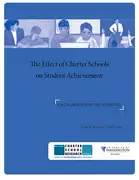Charter schools are largely viewed as a major innovation in the public school landscape, as they receive more independence from state laws and regulations than do traditional public schools, and are therefore more able to experiment with alternative curricula, pedagogical methods, and different ways of hiring and training teachers. Unlike traditional public schools, charters may be shut down by their authorizers for poor performance. But how is charter school performance measured? What are the effects of charter schools on student achievement?
Assessing literature that uses either experimental (lottery) or student-level growth- based methods, this analysis infers the causal impact of attending a charter school on student performance. Meta-analytic methods are used to obtain overall estimates on the effect of charter schools on reading and math achievement. The study finds that:
- Charter elementary schools on average outperform traditional public schools in both reading and math, and that charter middle schools outperform in math.
- At the high school level, there is no overall significant effect of charter schools. But results vary by locality: in some locations charter high schools are outperforming, while in others they are underperforming.
- Urban charters seem to perform better than suburban or rural charters, especially at the middle and high school levels.
- KIPP schools appear to have a statistically significant and very positive influence on both reading and math achievement, with the effect size for math being twice as large as for reading.
- Examining all of these results as separate parts of a whole, charter schools look to be serving students well, at least in elementary and middle schools, and probably better in math than in reading.
About two-thirds of the charter studies currently available were excluded from this review because there is strong evidence that weaker methods of study produce inaccurate findings.





